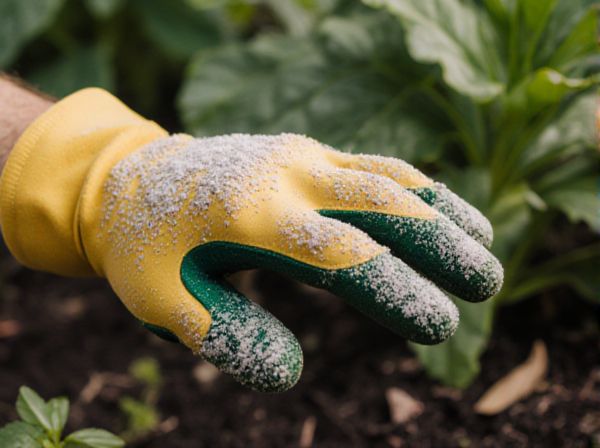
Sooty Mold vs Black Mold Illustration
Sooty mold is a superficial fungal growth that develops on plant surfaces, feeding on honeydew secreted by insects, and does not directly harm the plant's tissues. Black mold, on the other hand, refers to toxic molds such as Stachybotrys chartarum that grow on damp building materials and can cause serious health issues like respiratory problems and allergic reactions. While sooty mold mainly affects plant aesthetics, black mold poses significant risks to indoor air quality and human health.
Table of Comparison
| Aspect | Sooty Mold | Black Mold |
|---|---|---|
| Cause | Fungal growth on plant surfaces | Stachybotrys chartarum, toxic indoor fungus |
| Appearance | Black, powdery coating on leaves and stems | Black, slimy mold on damp building materials |
| Health Impact | Generally non-toxic, affects plant health | Produces mycotoxins causing respiratory issues |
| Growth Environment | Outdoors on plants with honeydew presence | Indoors on wet drywall, wood, or paper |
| Control Methods | Remove honeydew sources; apply fungicides | Professional removal; fix moisture problems |
| Detection | Visible coating; presence near aphid infestations | Musty odor; visible patches on walls and ceilings |
Understanding Sooty Mold in Gardens
Sooty mold is a type of fungal growth that develops on plant surfaces, particularly leaves and stems, where honeydew from aphids, whiteflies, or scale insects accumulates. Unlike black mold, which can cause health issues in humans, sooty mold primarily affects gardens by blocking sunlight and reducing photosynthesis efficiency in plants. Effective control involves managing insect pests and washing off the mold to protect plant health and maintain garden aesthetics.
What Is Black Mold? Key Differences
Black mold, scientifically known as Stachybotrys chartarum, is a toxic fungus commonly found in damp, cellulose-rich environments such as water-damaged buildings. Unlike sooty mold, which grows superficially on plant surfaces feeding on honeydew from insects, black mold penetrates deeper into building materials, posing serious health risks like respiratory issues and allergic reactions. Identifying black mold involves recognizing its slimy texture and dark greenish-black color, contrasting with the powdery appearance of sooty mold.
Causes of Sooty Mold on Plants
Sooty mold on plants is caused primarily by the growth of fungi in the family Capnodiaceae, which thrive on the honeydew excreted by sap-sucking insects such as aphids, whiteflies, and scale insects. This mold does not directly infect the plant but grows on the sugary secretions left on leaves and stems, blocking sunlight and reducing photosynthesis. Unlike black mold, which often originates from water damage and decaying organic material indoors, sooty mold is specifically linked to insect activity and environmental conditions favorable to fungal growth on plant surfaces.
Common Sources of Black Mold in Soil
Black mold in soil commonly originates from decaying organic matter such as fallen leaves, compost piles, and mulch, creating an ideal environment for fungal growth. Excess moisture and poor soil drainage further promote the proliferation of Stachybotrys chartarum, the toxic species often referred to as black mold. Unlike sooty mold, which primarily grows on plant surfaces feeding on honeydew, black mold thrives within the soil substrate, posing potential health risks when disturbed.
Identifying Sooty Mold: Symptoms and Signs
Sooty mold appears as a black, powdery coating on plant leaves and stems, caused by fungi growing on honeydew secreted by insects like aphids and whiteflies. Unlike black mold, which penetrates building materials and releases harmful mycotoxins, sooty mold primarily affects plant aesthetics and photosynthesis without producing toxins. Key symptoms include reduced plant vigor, chlorosis, and a sticky residue on leaves that attracts the fungal growth.
Black Mold: How to Spot Trouble in Your Garden
Black mold in your garden often appears as a dark, velvety growth on plant leaves and stems, distinct from sooty mold which primarily coats surfaces with a powdery black residue. This fungal disease thrives in damp, humid conditions and can quickly spread, causing leaf yellowing, wilting, and stunted growth. Early detection involves inspecting for black mold colonies along with signs of plant stress, enabling timely treatment to prevent significant damage.
Impact on Plants: Sooty Mold vs Black Mold
Sooty mold primarily affects plants by covering leaves, stems, and fruits with a black, powdery coating that hinders photosynthesis and reduces growth, often following the presence of honeydew-producing insects like aphids or whiteflies. Black mold, caused by fungi such as Stachybotrys chartarum, can penetrate plant tissues, leading to decay, wilting, and sometimes systemic infections that severely damage plant health. Both molds compromise plant vitality, but sooty mold is generally superficial while black mold poses a more aggressive threat requiring immediate management.
Prevention Strategies for Mold in Gardens
Implementing proper garden hygiene by regularly removing fallen leaves and plant debris significantly reduces the risk of sooty mold and black mold growth. Ensuring adequate air circulation through strategic plant spacing and pruning helps prevent mold spores from settling and proliferating on plants. Applying organic fungicides and avoiding excessive nitrogen fertilizers can further inhibit mold development while promoting healthy garden ecosystems.
Effective Treatment Options for Both Molds
Effective treatment options for sooty mold include physically removing the mold using a brush or cloth and addressing the underlying insect infestations, such as aphids or whiteflies, which produce the honeydew that promotes mold growth. For black mold (Stachybotrys chartarum), professional remediation involving thorough cleaning with fungicidal solutions, improving ventilation, and repairing moisture issues is crucial to prevent health risks associated with mycotoxins. Both molds require controlling the source of moisture or infestation to ensure long-term prevention and mold eradication.
Long-Term Solutions to Keep Gardens Mold-Free
Sooty mold, caused by fungal growth on honeydew secreted by pests, can be controlled long-term by managing insect populations like aphids and whiteflies through natural predators and horticultural oils. Black mold, a toxic fungus often found in damp environments, requires thorough moisture control, proper garden drainage, and regular removal of organic debris to prevent infestation. Implementing integrated pest management (IPM) and maintaining optimal garden hygiene effectively reduce both mold types, ensuring healthier plant growth over time.
Sooty Mold vs Black Mold Infographic

 gardendif.com
gardendif.com